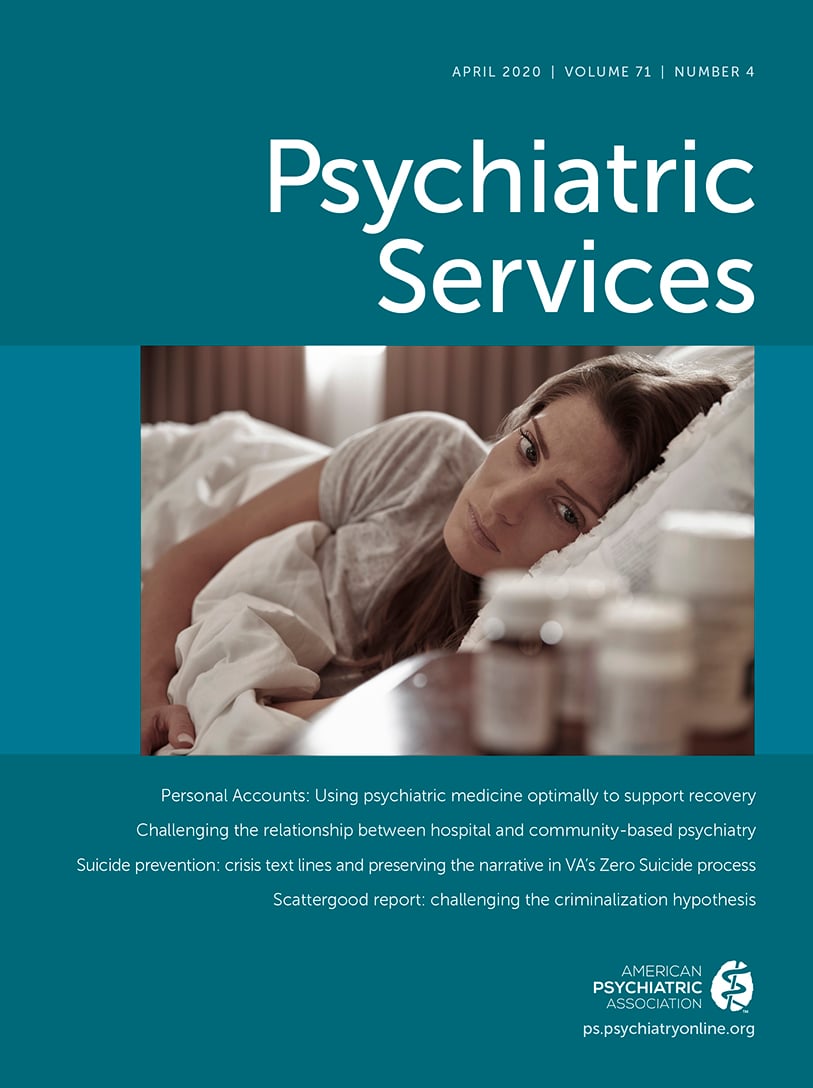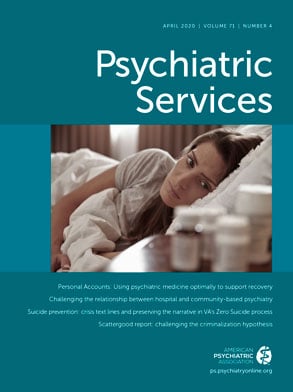Referrals to specialty clinicians are an important component of patient care, particularly for primary care physicians (PCPs;
1). Appropriate and timely referrals are especially important for individuals presenting with behavioral health conditions, including mental illness and substance use disorders. PCPs vary in their referral patterns (
2), and differences are based on clinical specialty and physician characteristics (
1,
3,
4). PCPs also differ in their ability to manage behavioral health conditions, resulting in variation in referral patterns (
2).
Diagnosis and treatment of behavioral health conditions are critical components of primary care because of high population prevalence, the likelihood that PCPs are the first treatment contact (
5), and specialist shortages (
5,
6). Whereas depression can be managed by PCPs (
5), other behavioral health conditions (e.g., schizophrenia) involve referral to a specialist as a component of providing guideline-concordant care (
7). Substance use disorders have historically been treated in a specialty services sector (
8). In addition, specialist supply and insurance networks constrain referrals. These issues are particularly salient in many areas for psychiatric and substance use disorder treatment (
5,
8–
10).
Despite the importance of PCP referrals for behavioral health conditions, no nationwide studies have examined the frequency of these referrals and associated factors. In this study, we used national data to examine PCP referrals for behavioral health diagnoses, an important clinical consideration. Most previous studies have focused on PCP patients with depressive symptoms rather than all behavioral health conditions (
2,
11); additionally, no previous studies have examined referrals in the U.S. health care system landscape.
Methods
Nationally representative data of PCP outpatient visits from the 2011–2015 National Ambulatory Medical Care Survey (
12) were used to determine whether PCPs had different referral rates for visits with a primary behavioral health diagnosis compared with other visits and whether rates varied across different behavioral health conditions. The National Ambulatory Medical Care Survey uses a complex survey design, weighted to be nationally representative of all office-based physician outpatient visits, excluding physicians in community health centers and hospital outpatient departments. Surveyed physicians contribute detailed visit information, abstracted from medical records, for 30 randomly selected visits (
12). The University of Massachusetts Amherst Institutional Review Board considered this study not human subjects research.
The analytic sample was outpatient PCP visits for patients age 18 or older with a new diagnosis or the acute exacerbation of a chronic condition as coded after the visit. We excluded visits with missing primary diagnosis (N=220) or regression covariates (N=3,801).
We used
ICD-9 diagnosis codes to determine whether the visit was primarily related to behavioral health and the specific diagnosis. We classified behavioral health conditions as psychoses, opioid use disorder, substance use disorder (excluding tobacco), depression, or all other behavioral health diagnoses (
13,
14) [see
online supplement]. We aggregated substance use disorder with and without opioid use disorder for the main results. The primary outcome was whether the visit resulted in a referral to another physician (without information about specialty or specific clinician).
We used t-tests and chi-square tests to determine whether differences between visits with and without referrals were statistically significant. Using whether the visit had a behavioral health primary diagnosis as the independent variable, a logit model was used to estimate whether the visit resulted in a referral (“unadjusted” results). To isolate associations between behavioral health conditions and referral probability, we estimated this regression while controlling for physician, organization, patient, and insurance characteristics (“adjusted” results). Specifically, we adjusted for patient sex, age, major reason for visit, number of diagnoses (maximum three in 2011–2013, five in 2014–2015), payment source, race-ethnicity, and patient comorbid conditions (i.e., arthritis, asthma, chronic renal failure, coronary artery disease, ischemic heart disease, diabetes, cerebrovascular disease, congestive heart failure, chronic obstructive pulmonary disease, hyperlipidemia, hypertension, obesity, and osteoporosis).
We also controlled for visit year, an interaction between year and number of diagnoses to account for measurement changes, geographic region, whether the physician was a full or part owner of the practice, office setting (private or group practice), whether the physician was in solo practice, whether the practice was owned by a physician or physician group, whether the practice used electronic medical records, and metropolitan statistical area location. Average marginal effects (AMEs) were used to interpret results as the change in predicted probability of the visit resulting in a referral.
Next, we compared associations of specific behavioral health primary diagnoses and changes in the predicted probability of a PCP visit resulting in a referral. We estimated a logit model with categorical behavioral health diagnoses as the independent variable (unadjusted) and then adjusted for physician, organization, patient, and insurance characteristics described previously (adjusted). We included substance use disorder with and without opioid use disorder as a sensitivity analysis.
All analyses were weighted to make results representative of national visits, with standard errors accounting for the complex survey design. An alpha of 0.05 was considered to be statistically significant.
Results
Population weighted results included 577,719,897 PCP visits (unweighted N=20,313) for a new condition or acute exacerbation in 2011–2015 [see online supplement]. A primary behavioral health diagnosis was present in 3.5% of visits. One in six visits resulted in a referral to another doctor, and primary behavioral health diagnoses were more common in visits with a referral. Referrals were statistically more common among visits with more diagnoses, visits paid by private insurance or Medicaid, and visits for patients with certain comorbidities.
Unadjusted results show that a behavioral health diagnosis was associated with an increase of 4.8 percentage points (unadjusted AME=0.05; 95% confidence interval [CI]=0.00 to 0.09) in the predicted probability of a referral. When controlling for patient, visit, physician, and organizational characteristics, we found that a behavioral health diagnosis was associated with a 4.3–percentage point increase (adjusted AME=0.04; 95% CI=0.00 to 0.09) in the predicted referral probability, a 26% increase in the referral rate.
Within behavioral health conditions, the unadjusted and adjusted predicted probability of referral varied by diagnosis (
Figure 1). The predicted probability of referral was higher by 23.9 percentage points among visits with a psychosis diagnosis compared with visits without a primary behavioral health diagnosis, and the difference was statistically significant (adjusted AME=0.24, 95% CI=0.06 to 0.42). The predicted probability of referral was 12.4 percentage points higher among visits with a diagnosis of substance use disorder compared with visits without a primary behavioral health diagnosis, but the difference was not statistically significant. No significant change in predicted probability of referral was associated with depression or other behavioral health conditions versus visits without a behavioral health diagnosis. Visits with a primary diagnosis of substance use disorder excluding opioid use disorder had a statistically significantly increased probability of referral compared with visits without a primary behavioral health diagnosis (adjusted AME=0.28; 95% CI=0.04 to 0.52), a large increase in magnitude of the AME from the combined referral rate for substance use disorders including opioid use disorder.
Discussion and Conclusions
In this study, PCP ambulatory care visits with a behavioral health diagnosis were associated with a significantly increased probability of referral. One of 29 visits included behavioral health as the primary diagnosis. Understanding PCP referral patterns for patients with behavioral health conditions is essential to improving health care access and care coordination. If PCPs are not able to adequately manage the patient’s clinical needs, referrals may be a necessary but not sufficient part of providing high-quality care for behavioral health conditions. In this study, we illuminated differences in referral rates for behavioral health conditions and quantified variation by specific diagnosis.
Differences across behavioral health diagnoses in regression-adjusted predicted probabilities of referrals showed that some diagnoses, including depression, were not associated with an increased probability of a referral. Yet, there was a significant positive association between referrals and a diagnosis of substance use disorder (excluding opioid use disorder) and psychoses. These differences align with expectations, in that PCPs commonly treat depression without a referral to a specialist (
5). We observed substantially higher referral rates for visits with psychoses diagnoses, which seems appropriate considering that guideline-concordant care for schizophrenia requires referral to a mental health specialist (
7). Higher referral rates for substance use disorder reflect treatment primarily occurring in a specialty services sector, particularly for substance use disorders other than opioid use disorder (
8).
Our findings reflect clinical practice for new problems and acute exacerbations of chronic problems, including visits across the acuity spectrum and PCP experience with screening, diagnosis, and treatment of behavioral health conditions. Our results are in line with previous estimates of PCP referral rates (11%–36%), which vary widely and are based on psychiatric or depressive symptoms rather than behavioral health diagnoses (
1,
2,
11).
This analysis had several limitations. First, because of survey limitations, we restricted analysis to office-based physicians and excluded visits in hospital outpatient departments, possibly underestimating outpatient referrals. Second, in line with previous literature, we used primary diagnosis codes to categorize visits (
13,
14), reflecting PCP screening and diagnosis patterns for behavioral health conditions. Third, the referral indicator does not estimate completed referrals; there are low completion rates for PCP referrals (
15), and thus these referrals may not ultimately contribute to patient care. Fourth, we were not able to distinguish referral targets; the outcome is not limited to referrals to psychiatry or addiction medicine specialists. However, the limitation to primary diagnoses makes it more likely that the behavioral health condition was the referral reason. A better understanding of referral patterns supports ongoing efforts to integrate behavioral health and primary care and to improve quality of behavioral health treatment. In future studies, researchers should build on this report by examining to whom patients with behavioral health conditions are referred, hopefully by using more detailed visit-level data than are currently available on the national scale.
Our findings document clinically meaningful differences in PCP referral rates for patients with primary behavioral health diagnoses, which vary substantially by behavioral health condition. In future studies, researchers should examine whether referral rates represent adequate treatment for behavioral health conditions and influences on these referral patterns. Improved discernment of PCP referrals for behavioral health conditions contributes to improvements in determining how to allocate resources between primary and specialty care while optimizing patient care.
Acknowledgments
The authors thank Kia Kaizer, B.S., for research assistance.


